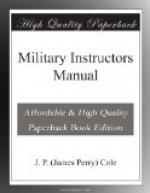To maintain the efficiency of a command, troops must have adequate shelter.
Sanitary Considerations Around Camp:
Latrines on opposite side of camp
from kitchens.
Short camps, straddle trenches.
Long camps, trenches 2 by 6 by 12
with seats.
Have latrines screened.
Burn the trenches out daily and
keep covered.
Wash boxes and paint with tar.
QUESTIONS AND ANSWERS ON F.S.R.
1. How are the land forces of the U.S. organized?
Ans.—The Mobile Army consisting of Regular Army, organized land militia when called to Federal service, drafted army, volunteers and the field artillery and the Coast Artillery.
Basis of organization is the Division composed of all arms and self-sufficient. Several divisions may be grouped into a field army, to which are attached field army troops. These are organized into a brigade for purpose of supply and administration when necessary through numbers.
Coast Artillery is charged with the care and use of land and coast fortifications, including submarine mines and torpedo defenses.
2. What is the object of collecting military information?
Ans.—To enable the War Department to decide upon the size of army or expedition, the proportions of different arms, the character of clothing, equipment, etc., needed for any operation.
Information collected by the Gen. Staff in time of peace should include geography, physical resources, and military strength of the various nations.
3. Define reconnaisance.
Ans.—Reconnaisance is used to designate the work of troops or individuals when gathering information in the field.
It is necessary during combat for the tactical use of troops.
It is carried on by: (a) aero squadron; (b) independent cavalry; (c) divisional cavalry; (d) by infantry as reconnoitering patrols.
4. What are some indications of the presence of the enemy?
Ans.—Clothing or material on roads or in abandoned camps.
A thick, low cloud of dust indicates infantry.
A high, thin cloud cavalry.
A broken cloud artillery or wagon trains.
How would you determine from these indications what the number and organization of the enemy might be?
Ans.—Estimate strength by length of time it takes to pass a given point. Assuming that infantry in column of squads occupies half a yard per man, cavalry in column of fours 1 yard per trooper, and artillery in single column 20 yards per gun or caisson, a given point would be passed in one minute by about: 175 infantry, 110 cavalry at walk, 200 cavalry at trot, 5 guns or caissons.
5. Suppose on patrol and safely concealed for sighting the enemy at no great distance, by what rough method would you ascertain the approximate strength of the force assuming it to be composed of infantry, cavalry and artillery?




